Raccoons are not small. In fact, they can easily weigh up to 20 pounds. They are also incredibly intelligent and use their paws like hands. They have been known to open doors, jars, lids, windows, and even hatches. Thanks to this large body mass and dexterity, they can do a lot more damage to your home than a smaller animal like a mouse or squirrel.
Raccoons And Soffits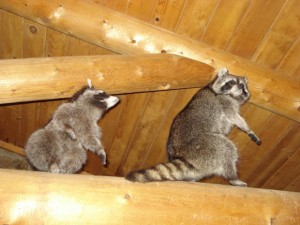
Raccoons seem to enjoy making dens in chimneys and attics. Their point of entry is soffits and they are not afraid to chew their way through. There are several reasons that raccoons find soffits an easy target. Soffits are generally located in low-traffic areas of the home. Many times, raccoon-induced damage may go unnoticed for quite a long time. In fact, by the time you see it, your raccoon may have multiplied! Soffits also are warm with dry air, which is very enticing to a raccoon. They also are usually easy to reach and easy to pry open for dexterous raccoons. Soffits are also generally protected from weather.
What To Do If Raccoons Move In And Raccoon-Proofing Your Home
So, a raccoon chewed through your soffit and moved into your home. The first thing you have to do is have the raccoons removed. You should not try to remove these creatures on your own. Without meaning to, you could endanger yourself or the raccoons. You could even be in violation of a local wildlife removal ordinance. You should start by calling a trained wildlife removal professional like Attic Solutions who are familiar with humane and effective raccoon removal procedures. You do not want to try to separate a mother raccoon from her kits. You might not live to tell about it! Once your raccoon family is humanely evicted, you need to seal and secure all points of entry. Sturdy, hardware wire mesh is usually adequate, although metal bars or panels also work depending on the design of your soffit. Just be sure to fix it properly so another unwelcomed guest doesn’t try to move back in.




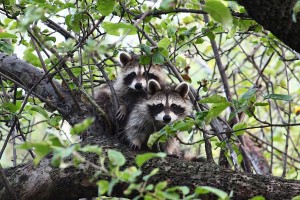
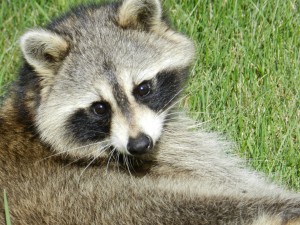 Just like humans,
Just like humans, 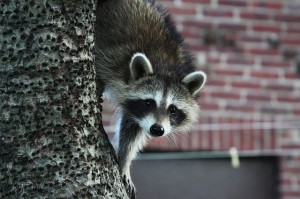
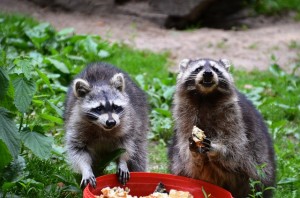 Raccoons are certainly not picky eaters; in fact they will eat just about anything. Raccoons are carnivores as well as scavengers. The mainstays of their diet include mice, crabs, fish, frogs, nuts, and seeds. They also love to get into food that humans leave behind. This is why you may find your garbage strewn about if you leave it out overnight.
Raccoons are certainly not picky eaters; in fact they will eat just about anything. Raccoons are carnivores as well as scavengers. The mainstays of their diet include mice, crabs, fish, frogs, nuts, and seeds. They also love to get into food that humans leave behind. This is why you may find your garbage strewn about if you leave it out overnight.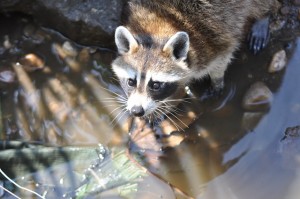 Perhaps one of the most unusual habits raccoons have is dunking their food in water before eating it. The raccoon’s scientific name is procyon lotor, which actually means “washing bear.” This makes sense considering their odd food-washing habit and bear-like markings. Raccoons are nocturnal animals, meaning they are active at night. Most raccoons spend the day in their dens and as soon as dusk approaches, they head out in search of food. Some places raccoons like to search include farms (crops are a big hit with them), ponds, lakes, and of course your garbage can. As sunrise approaches, raccoons typically call it a night and head back to their den to sleep.
Perhaps one of the most unusual habits raccoons have is dunking their food in water before eating it. The raccoon’s scientific name is procyon lotor, which actually means “washing bear.” This makes sense considering their odd food-washing habit and bear-like markings. Raccoons are nocturnal animals, meaning they are active at night. Most raccoons spend the day in their dens and as soon as dusk approaches, they head out in search of food. Some places raccoons like to search include farms (crops are a big hit with them), ponds, lakes, and of course your garbage can. As sunrise approaches, raccoons typically call it a night and head back to their den to sleep.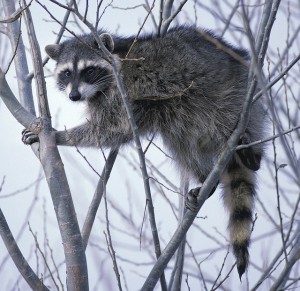 Raccoons do not hibernate in winter. This myth may have started because during very cold days raccoons take refuge in their warm dens. Depending on the climate and weather, raccoons may spend weeks in their dens, living off of their fat stores, until the climate becomes somewhat more mild. When raccoons are sleeping off the cold temperatures, those fat stores keep them alive since they do not eat. This is why raccoons seem to be particularly troublesome in the spring; they’re starving and they want YOUR garbage!
Raccoons do not hibernate in winter. This myth may have started because during very cold days raccoons take refuge in their warm dens. Depending on the climate and weather, raccoons may spend weeks in their dens, living off of their fat stores, until the climate becomes somewhat more mild. When raccoons are sleeping off the cold temperatures, those fat stores keep them alive since they do not eat. This is why raccoons seem to be particularly troublesome in the spring; they’re starving and they want YOUR garbage! Imagine you are in your bed, happy to be lying down after a long day but your rest is abruptly interrupted by loud scratching noises coming from your walls or attic.
Imagine you are in your bed, happy to be lying down after a long day but your rest is abruptly interrupted by loud scratching noises coming from your walls or attic. 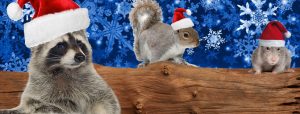 The Chicago area is in the middle of one of the coldest winters to ever hit this area and as a result, people are not the only ones looking indoors for shelter.
The Chicago area is in the middle of one of the coldest winters to ever hit this area and as a result, people are not the only ones looking indoors for shelter.